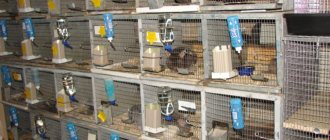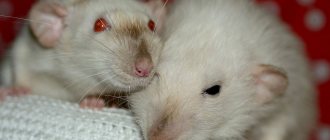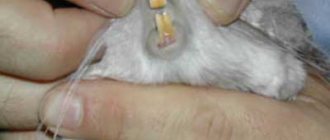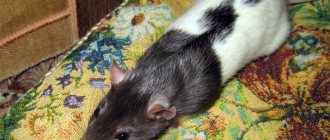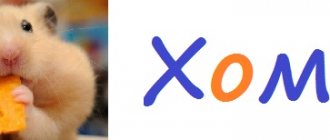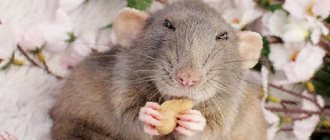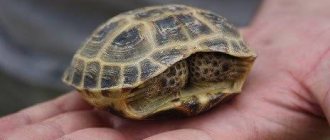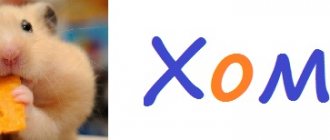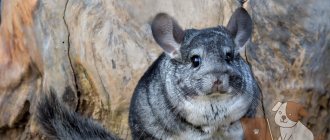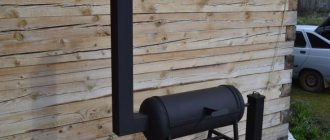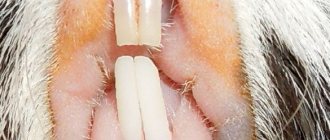- home
- Chinchilla
- Health
03/21/2019 You can quickly become friends with such an unusual and cheerful pet as a chinchilla. The rodent brings a lot of joy to both children and adults. And if a pet dies, it becomes a real tragedy for all household members. This article answers questions about why rodents die and how to recognize the symptoms of impending disaster.
Chinchilla death: how to find out the cause and help a dying pet
Chinchillas become family and beloved pets from the moment they acquire an unusual rodent. Sometimes an absolutely healthy animal dies unexpectedly, which becomes a tragedy for all family members and the question arises, what can a chinchilla die from at home? Most often, the sudden death of a chinchilla can be caused by a violation of the conditions of feeding and keeping exotic animals; often chinchillas die from an advanced disease that went unnoticed by the owner of the animal.
The main causes of death of domestic rats
Unlike their wild relatives, domestic decorative rats are not characterized by good health; they are predisposed to cancer. This is especially true for albinos, who have a lower level of immunity compared to representatives of other breeds.
The list of the most common pathologies includes:
The lifespan of rats is also significantly influenced by housing conditions and nutrition.
Feeding sweets, smoked, fatty and salty foods leads to the development of obesity, liver and pancreas diseases in pets. The introduction of citrus fruits, honey, chocolate and some other products into the diet provokes allergic reactions that significantly weaken the immune system of rats, making them more susceptible to various diseases and leading to death.
Allergies can also be caused by low-quality sawdust or napkins containing dyes and fragrances. In pets who live in poor sanitary conditions, diaper rash and ulcers form on the paws and stomach, leading to the development of purulent inflammation, sepsis and death.
Particular attention should be paid to the safety of rats, especially if there are other animals or small children at home. You should not allow your pet to fall from a great height (relative to their size), forceful compression or blows, which can easily cause pathologies of internal organs and subsequent death.
You should also be aware that some rats die from fright or extreme stress. In white rats, stress can cause allergies, which manifest as scratching and hair loss.
The accelerated metabolism inherent in rodents leads to the rapid development of pathologies. Therefore, even with timely treatment, the rat often dies within a matter of hours.
However, some pets live to a ripe old age, maintaining their appetite and activity. Such rats often die without pain or agony.
Determination of skin quality
Each villus of the animal has separate zones, which are divided into three parts:
- The lower part is dark gray in color;
- The middle part has a thin white stripe;
- The upper part has a haze at the tip, which can be said to determine the main color of the chinchilla skin.
The color of the animals is heterogeneous throughout the body. Thus, the color of the abdomen is predominantly white, but can sometimes be grey. It is believed that the lighter the stripe on the belly, and the sharper the dark color it acquires on the side, the higher the quality of the material.
As for clearly established rules for skins, there are none today. Sometimes fashion itself dictates them; in addition, breeders always improve breeds and develop new types with new colors. But there are still basic criteria for determining quality:
- Large skins;
- The fur should be thick and lush, in addition, its shine should have a noticeable veil that is uniform in color and density;
- The color must be clean, both regionally and overall;
- Attention is also paid to the length of the pile and the elasticity of the hairs.
The fleecy cover of animals develops in several stages:
- Primary type of fur. This type of chinchilla fur can be seen on newborn puppies and remains for up to 2 months. In addition, their fur is not divided into zones;
- Fur of a young individual. It is he who appears in the first stages of animal maturation. This period occurs in 3-6 months. At this age, the animals' hair becomes silky and is more pleasant than that of an adult chinchilla. True, the skin at this age is small, and the skin itself is very fragile and delicate;
- Fur of an adult pet. Achieved between 7 and 8 months and up to 1 year. At this time, the maximum maturity of the pile is maintained for several days, up to 1 week. After this, it turns into a hard and faded material.
As for determining the maturity of the fur itself, it can be identified by a couple of signs: skin color and hair quality.
When maturity is sufficient and the hair is ideal for sale, all hairs should be of the same length. In addition, no new growths should be visible from the bulbs. The maturation of the integument along the body of animals occurs unevenly. Initially it occurs from the head and then extends to the tail and chest.
If you determine maturity by skin, namely by color, then you need to blow on the fur. It should swell to the sides so that the skin is visible. If it has cold colors, then the skin is not yet mature, but the hair is still growing. If the skin has pink tints, then the skin is mature. The skin may also be red. In this case, the skin is overripe.
Slaughter and skinning
An animal can be slaughtered using several methods:
- Using current;
- Using chloroform or ether.
If you use the latter method, then the animals must be placed in wooden boxes, approximately 20x20. Such a box should not have holes or cracks, but there should be an observation window. Next, there should be a small hole in the box itself, to which the top lid fits. Cotton wool is placed in it, on which 50 grams are first dripped. ether or 20 gr. chloroform. When using the first drug, the animal will fall asleep in a quarter of an hour; when using the second drug, the animal will die after 5 minutes.
To speed up this method, it is recommended to install the box in a warm place. During slaughter, animals should be handled exclusively by the tail, and before skinning, it is better to place the carcass on its stomach for a couple of hours, while stretching it by the paws. Thus, the body will cool down and become solid.
Before removing the skin, you will need to clean the body of fat. To do this, use a special board on which the chinchilla should be laid on its back. The skin must be removed in layers. But before that, you should make a cut along the entire lower part.
Initially, the skin is cut around the anus, as well as in the genital area, after which you can move on to the hind legs. After this, the incision should be made all the way to the head, namely to the nose. With each new cut, the skin must be pulled in different directions by about 3 cm.
Removal is carried out initially from the forelimbs. To do this you need to cut your wrists. After this, you should tear off the skin from the head, while cutting the cartilage of the ears, as well as the skin near the lips, nose and eyes. The part that has already been freed, namely the head, should be taken in your hand and then the procedure for extracting the skin should be completed.
When removing skin, it is important not to get any blood or fat on the fur. After receiving the material, you must immediately use a dull knife to clean the skin from any remaining tissue and fibers.
To do this, the material should be placed on the table and the paws and tail should be leveled.
Also, the skins may not be repaired, but in this case the cost will be lower. If we talk about how much a chinchilla skin costs, then in its raw form its price is approximately $50. And if the skin is processed and of high quality, then you can earn about 100 dollars or more. To dry the leather, stretch it on a special board and secure it with nails along the edges. There is no need to pull the skins very hard, the main thing is to remove the folds.
When is resuscitation required?
If your pet suddenly loses consciousness or his heart stops, the main thing is not to panic, but to try to provide him with first aid.
Remember, in this situation, minutes count and you can’t lose them! The further fate of the animal will depend on how quickly you begin to act.
Clinical death lasts only a couple of minutes and at this time there is still hope to save the four-legged friend, then biological death occurs, brain cells die and it is no longer possible to help.
How to understand the condition of an animal:
- see if your pet is conscious
- check pupil reaction to light
- determine the ability to breathe
- feel the pulse
If breathing stops, call a veterinarian immediately and begin artificial ventilation.
Reasons for refusing to eat
Some chinchillas are very picky eaters and may refuse to eat if the food is not fresh, monotonous, or the animal is not in the mood. Also, a furry pet may refuse the offered food in the hope of getting a more tasty treat. Animals often lose interest in food after experiencing stress. A new home, moving, visiting a veterinary clinic, or moving in with a new neighbor can cause stress. In this case, it is better to give your pet peace, talk to him kindly, and offer him his favorite treats.
However, in most cases, refusal to eat signals a health problem. The most common of them:
- Inflammation of the gastrointestinal tract (catarrhal),
- Heatstroke,
- Food poisoning,
- Problem with teeth
- Flatulence.
Catarrh
Catarrhal inflammation of the gastrointestinal tract can be of a cold nature, and also have an acidic or alkaline form.
Each form of the disease has some similar symptoms - refusal to eat, loose stools, accumulation of feces around the anus, lethargy. The cold form of the disease is characterized by yellowish feces; the chinchilla often sneezes and rubs its nose. With the acid form of inflammation, the chinchilla defecates very often, the feces have a sharp sour odor and are grayish in color. The alkaline form of inflammation is characterized by rare, but very loose stools that have an unpleasant smell of rot.
Treatment of the disease depends on the form of inflammation. Acid catarrh is treated with Syntomycin, which is given twice a day, 0.2 grams. A decoction of oak bark and a one percent tannin solution are also recommended. Alkaline catarrh is treated with drops of Salol, which are instilled into the animal’s mouth. A weak solution of ordinary potassium permanganate also helps. The cold form of the disease is treated with Biomycin. It is given twice a day, 0.2 g. It is also necessary to use nasal drops - one percent Furacilin or a 33% aqueous solution of Ecmonovocillin.
Any form of catarrhal inflammation requires a strict diet for the animal.
It is necessary to exclude everything except fresh and clean hay, as well as water. When the animal’s condition has returned to normal, they begin to give grated carrots, chopped oats and oat decoction. After this, regular feed is introduced.
Poisoning
Poisoning in a chinchilla can be caused by too salty food or toxic substances getting into the food. These include both poisonous herbs and various nitrates and other pesticides. Salt poisoning is characterized by refusal to eat, loud grinding of teeth, excessive salivation, severe thirst, and loose stools. The chinchilla becomes lethargic and refuses to make contact with its owner. Sometimes salt poisoning is accompanied by paralysis. Treatment for salt poisoning involves drinking milk or natural vegetable oil through a syringe. It is also necessary to administer 5% calcium chloride subcutaneously:
- For young individuals - one milliliter,
- Adults - three milliliters.
Poisoning can also occur as a result of eating poisonous grass or canopy, mold and rot along with hay.
Symptoms of poisoning vary depending on the amount of poison that enters the animal’s body. The most dangerous is severe poisoning, in which the chinchilla dies within two to three hours after feeding. Symptoms are severe diarrhea with a lot of blood, drooling, bloody discharge from the mouth, foam, refusal of food and water, convulsions, heavy and hoarse breathing. In case of acute poisoning, animals experience diarrhea or constipation (depending on the poison), bloating, the animal has poor coordination in space, and frequent convulsions appear. Poisoning can also be chronic. Symptoms are observed within one to two days:
- Refusal to eat
- Apathy,
- Pale mucous membranes,
- Loss of shine in fur
- The animal is rapidly losing weight.
For successful treatment, the source of the poison entering the chinchilla’s body must be determined. In the first hours after the onset of symptoms, it is recommended to give the animal strong emetics (Anamorphine) or laxatives, and also be sure to rinse the stomach. For washing, use ordinary warm water, in which crushed charcoal (you can use activated) charcoal is dissolved. Flax seed decoction, milk or any dairy products also help well.
Poisoning is always accompanied by severe dehydration, so it is necessary to monitor the constant presence of water in the drinking bowl.
If the pet does not drink, it is given artificially from a syringe every hour.
Dental diseases
Most often, a chinchilla does not eat due to dental problems. Hooked teeth or malocclusion is a common and common disease not only in chinchillas, but in all rodents. First symptoms:
- Poor appetite or refusal to eat,
- Fast weight loss,
- The animal chews each piece of food for a long time and thoroughly,
- Selects only the smallest and softest pieces,
- Profuse salivation
- Inflammation of the tissues of the lower jaw.
A more serious stage of the disease is accompanied by lethargy, copious discharge from the eyes and nose.
The cause of the problem is a genetic predisposition to improper placement of molars in the oral cavity. This leads to improper grinding of the molars - the rubbing surface as a result of such grinding comes into contact with the grinding surface of another tooth at an acute angle. Long and very sharp hooks form on the surface of the tooth, which injure the delicate mucous tissue of the cheeks, palate and tongue. This causes severe pain to the animal and makes it difficult to chew and swallow food.
When the disease is advanced, the pet loses more than ten percent of its weight, bowel movements become rare and are often in the form of very loose stools, the animal constantly rubs its muzzle and tries to get something out of its mouth, often yawns, and shows restlessness.
Treatment is carried out by removing or filing the hooks. If the disease is advanced, then the correction must be repeated every 4 - 5 months until the bite is completely restored. The procedure is carried out only in a veterinary clinic and under anesthesia.
Flatulence
Bloating in chinchillas usually occurs when too much green and juicy food is included in the diet. Green feed (especially legumes - clover and alfalfa) cause strong fermentation and gas formation. The disease is also accompanied by noisy and difficult breathing. Characteristic cramps are heard in the tummy. The pet becomes lethargic and refuses food and water. In more rare cases, flatulence leads to cramps. After convulsions, the chinchilla’s body temperature drops sharply to a dangerous 34.5 degrees. Young and weak animals may die at this moment.
Treatment of flatulence involves the use of adsorbent drugs:
- Espumisana,
- Carbolena,
- Activated carbon.
Magnesia and antibiotics have also proven themselves well: Etazol and Norsulfazol. They are given in 45 - 50 grams. You can also give Biomycin - about 20 grams. When treating flatulence, it is necessary to force the animal to move, since usually a sick chinchilla prefers to sit or even lie down. Movement is necessary to restore bowel function. A tummy massage, as well as an enema with warm and slightly soapy water, will also help.
On the first day after symptoms of the disease are detected, all hay and any remaining feed are removed from the feeders, leaving only water. On the second day, if the dynamics are positive, you can give the animal a little hay. On the third day - a little hay and granulated food.
Heatstroke
Keeping your pet improperly or living in a hot climate can lead to heat stroke. Overheating of the chinchilla's body is accompanied by:
- Lethargy,
- Refusal to eat
- The animal doesn't drink
- Breathing and heart rate increase,
- The mucous membranes become pale.
Severe overheating can also cause convulsions, animals fall on their sides and lose coordination of movement.
Severe heat stroke can cause the death of an animal.
First aid is to move the chinchilla to a cool, shaded place with good ventilation but no drafts. You can place a damp, cold towel on your head. If heat stroke causes convulsions, it is necessary to give an intramuscular injection with a caffeine solution - no more than two milliliters, and in case of heart problems, no more than two milliliters of twenty percent camphor oil and about twenty milliliters of a twenty percent solution of ordinary glucose are injected subcutaneously.
physical characteristics
Chinchillas have a lot in common with guinea pigs and porcupines. With short front legs and long, muscular hind legs, chinchillas are similar to rabbits, but their ears are much shorter and rounder. They have large black eyes and bushy tails. They also have four toes on each foot, and the thin claws on each toe are surrounded by stiff bristles.
Chinchillas are typically between 23 and 38 centimeters long, but the tail can add another eight to 15 centimeters to their length. They usually weigh between 0.5 and 0.8 kilograms.
Intestinal parasites
Infection with worms is quite common and is epidemic in nature. A small infection may be invisible to the owner and the animal may not show signs of concern. However, if there are a lot of parasites, this leads to noticeable weight loss, frequent digestive problems, and parasite eggs can be found in feces. It is recommended to treat with Furazolidone. One tablet is crushed and added to the drinking bowl.
The course of treatment is ten days. At the same time, the animals must be given Nemozol through a syringe - 15 ml per kilogram of live weight. The medicine is given twice a day for a week and repeated after ten days.
During treatment, careful cleaning and treatment of the cage is necessary.
Rectal prolapse
The rectum can prolapse in both males and females. The rectum in chinchillas does not just fall out; it usually happens after long-term illnesses that have not been treated, for example, constipation.
Only a veterinarian can be trusted to set the intestine back, so as not to harm the animal. In addition, you will do double benefit to the animal, because the doctor will be able to determine why it fell out and prescribe treatment.
If you do not take the animal in time, the intestine will dry out and it will no longer be possible to save the animal; instead, it will die painfully.
Gnawing fur
It happens that chinchillas gnaw out whole pieces of fur on themselves or their relatives.
This happens from stress after transportation, from being placed with another animal, or pregnancy.
- The animal needs to be isolated; it is better to cover the cage with a dark cloth and try not to disturb it.
- If within 5 days the pet does not gnaw out fur on new areas of its body, then there is a chance that all the fur will grow back and the animal will get rid of its bad habit.
- If a chinchilla does not stop chewing its fur, it may be lacking vitamins A, D and E, calcium, potassium, phosphorus, and methionine.
Hair chewing is difficult to cure, and it is worth trying all known methods.
Then you just need to choose a rich food. Perhaps the animal needs to undergo a course of treatment with vitamins, that is, they are administered intramuscularly for 10 days. You can feed your pet multivitamins for 10 days, and after another 10 days repeat the course. You can add lard to the animal's food, then the feeder will need to be washed daily. This treatment will take the longest. But with each method, you must put a mineral salt stone and hay in the chinchilla’s cage.
Constipation in chinchillas
Constipation occurs for many reasons and should be treated as soon as possible. Typically, constipation occurs due to poor food, changes in food, immobility of the chinchilla, gastrointestinal diseases, infections, etc. Sometimes constipation occurs due to severe stress and fear.
More detailed article about constipation here
Constipation symptoms:
- Boluses (poop) become smaller than usual
- There are fewer boluses, and in advanced cases there are no boluses at all.
- Refusal to eat
- Fixed and lethargic. In some cases, he sits in the corner with his tail between his legs.
- Sometimes makes mournful sounds
Constipation is not difficult to cure at home, but if the illness lasts for several days and there is no improvement, then it is better to consult a veterinarian. It is especially important to consult a doctor if there are no boluses for more than 2 days, the animal can quickly die.
If your chinchilla is constipated, then go to another article on our website with decoction recipes and a list of medications.
If there are no serious violations, then you can begin self-treatment of constipation:
- The most important thing is to give as much water as possible. If the animal does not drink on its own, then you can drip it into the mouth from a regular syringe.
- The cage needs to be cleaned and all food removed. Put in good fresh hay.
- If boluses come out, then you can start with decoctions, without using laxatives. A decoction of flax seeds works very well. It must be boiled and left until the water becomes thick. Give the chinchilla 2-3 ml from a syringe 3 times a day.
- If there is no improvement, then you need to give a laxative. You will find laxative recipes here.
- For severe constipation, do an enema with salted water.
Malocclusion
Malocclusion develops due to malocclusion, that is, improper closing of the jaws. Insufficient grinding of growing teeth causes the formation of hooks.
This pathology develops for the following reasons:
- unbalanced diet;
- lack of essential minerals;
- autoimmune diseases;
- injuries to teeth or jaws;
- genetic factor.
Malocclusion has its own characteristic symptoms - the rodent refuses to eat food, which is why it begins to rapidly lose weight. The animal eats reluctantly, having first sorted the food in its paws for a long time, and eats only the smallest and softest grains. Further, there is excessive separation of tears and movements reminiscent of gagging. When the form is advanced, the animal begins to salivate heavily, stomatitis (a disease of the oral cavity in which painful ulcers form) appears, and the stool becomes soft or liquid. The rodent's tongue is injured by the sharp edges of overgrown teeth, resulting in bleeding, painful wounds in the mouth. If you do not contact a specialist in time, the animal dies.
If the disease was detected in the later stages, the animal will most likely need to be helped in eating after teeth trimming. To nurse your pet, feed is ground and administered using a syringe. Thanks to this, the animal understands that there is no pain and begins to eat on its own.
Prevention of malocclusion
Like most other diseases, malocclusion is easier to prevent than to treat. To avoid the development of this disease, experts advise:
- Provide your pet with proper nutrition, which should include granulated food, mineral stones, and branches.
- Hay must be included in the diet. It is the main source of fiber and helps to wear down molars.
Granulated food is great for grinding teeth , but it should not become a substitute for natural food. It is best to take branches from the following trees:
In addition to mineral stone, you can purchase wooden toys for rodents. As a preventive measure, experts recommend showing the animal to a veterinarian at least once a year.
Source
Prevention is better than cure
The main diseases of chinchillas are diseases of the digestive system and skin. The animals most often suffer from diarrhea and intestinal upset, which can only be cured by restoring the intestinal microflora. For this purpose, chinchillas need to be given activated carbon, bifidumbacterin and raisins.
Constipation causes stool to become small, dry, round, or irregular in shape. This means that the chinchilla's digestive system slows down, causing stool to dry out and making it difficult to have bowel movements. Often constipation signals that the animal is not eating or drinking. In this case, the main problem becomes dehydration, and constipation is only a consequence of dehydration.
Preventing constipation is much easier than dealing with its consequences. To prevent constipation, the following rules must be followed:
1) the animal should always have access to water, it helps maintain the moisture content of feces necessary for movement through the intestines;
2) chinchillas need enough hay, since coarse dietary fiber stimulates intestinal motility;
3) an animal suffering from constipation is treated with sunflower oil and given sunflower seeds and raisins.
Skin diseases usually occur due to poor cell cleaning. And if this does happen, the damaged areas must be treated with an antifungal aerosol. Frequent use of such a strong medicine can burn the skin of a delicate animal, so after several aerosol treatments, treatment can be continued with a special antifungal ointment. Usually 3-4 treatments are enough.
1.General information
Such phrases as “healthy shine of hair”, “silky skin”, “strong nails”, etc. - often used in advertising and literature. Nature itself provides certain optical, tactile, physical-mechanical (firmness, strength, elasticity) characteristics of the external structures of the body, which are unconsciously perceived as signs of health, and therefore beauty. And on the contrary, the loss of these characteristics signals one or another problem.
Dry skin, brittle nails and hair that has begun to fall out are not a cosmetic problem. This triad of symptoms is well known in many areas of medicine, and the list of diseases in the clinical picture of which it is included is surprisingly wide. This includes pathology of the gastrointestinal tract, and diseases of the kidneys, respiratory organs, and oral cavity; chronic infectious and inflammatory processes, dysfunction of the hematopoietic and immune systems; a number of neuropsychiatric disorders (endogenous depression, anorexia, etc.). There are even more known external and situational risk factors: environmental and occupational hazards, stress, bad habits, hypovitaminosis, overwork, taking medications, household chemicals and personal care products, etc.
However, upon careful study of the problem, it turns out that all these causes and factors, no matter what area they belong to, ultimately come down to metabolic disorders. In turn, these complex biochemical processes are under the control of neurohumoral regulation, which is carried out by the interaction of the nervous system and its faithful “executor” - the endocrine system, i.e. a complex of endocrine glands that produce hormone regulators. Certain changes in the skin, nails and hair are inherent in almost any hormonal disorder (diabetes mellitus, genetic, inflammatory, oncological diseases of the endocrine glands, age-related changes, etc.)
But in cases where there are no more severe and obvious symptoms, you should pay attention to the condition of the thyroid gland. This dicotyledonous, butterfly-shaped (sometimes compared to a logo) endocrine gland is located in the front of the neck and is involved in a number of key physiological processes - bone formation, growth and maturation, control of iodine in the body, provision of cardiovascular, reproductive, digestive, mental activity
Thyroid hormones - thyroxine, triiodothyronine, calcitonin - must be in a strictly defined concentration and balance, any displacements of which (hypo- and hyperthyroidism, thyrotoxicosis) have an extremely detrimental effect on the condition of the entire organism as a whole. And the first, preclinical signs are often those phenomena that are included in the title of the article.
How short should a chinchilla's whiskers be trimmed?
Most owners recommend keeping them between 2.5 and 5 cm long, but you can cut them shorter. Some owners even trim them down to stubble. This dramatically changes the chinchilla's character, making it less aggressive.
There are two problems with cutting a chinchilla's whiskers so short. Firstly, it will be difficult for him to find his way. The second problem is that you can injure your chinchilla if you trim his whiskers so short. Some chinchillas refuse to sit still when picked up, making this job much more difficult.
Allergy
A chinchilla's runny nose can also be caused by an allergic reaction to dust, bedding or hay. With allergies, a chinchilla sneezes, often rubs its nose with its paws, and there may be eyelid swelling and difficulty breathing. Treatment of chinchillas for allergies consists of completely eliminating the allergen: replace the hay and bedding, rinse the cage thoroughly, change the water, and return all the usual food. Among medications, Suprastin has proven itself well.
However, most often, cleaning the cage and eliminating the allergen from the animal’s environment is enough.
To watch online, click on the video cudarrr;
CHINCHILLA STROKE! Why does it occur? How to avoid and how to TREAT? More details
Chinchilla after a stroke Read more
Injections for CHINCHILLAS. Should you stab chinchillas yourself? More details
CHINCHILLA CONSTIPATION! What to do? How to treat it? More details
Chinchilla Bob came from afar for treatment at the Lucky veterinary clinic Read more
Our old man Shusha is dying. More details
Stroke in a chinchilla Read more
Chinchilla is furious! More details
Chinchilla Seizures (Caesar) More details
VLOG Shushi is no more Read more
CHINCHILLA sounds! What do they mean? More details
What does a chinchilla need? How to maintain it? What do you need to know before starting it? More details
Stomatitis
Chinchilla diseases are often infectious. One of the most common infectious diseases is stomatitis.
Stomatitis in chinchillas is most often caused by a viral, bacterial or fungal infection, and the cause is a weakened immune system, lack of iron in the body, or severe infestation with worms.
Symptoms are increased salivation, constantly wet fur around the mouth and on the chest, refusal to eat, strong and unpleasant breath. What should you do if you notice these signs? Stomatitis must be treated by treating the animal’s oral cavity three to four times a day with Metrogildent or Lugol. It is also recommended to rinse the chinchilla's mouth with Chlorhexidine.
Infectious stomatitis in chinchillas
Dangers
Of course, there are a lot of dangers in an apartment for such a small and delicate animal, and it can be difficult to keep track of a chinchilla.
The first category of danger for rodents when walking is the home interior. For example, due to the fact that chinchillas are very inquisitive by nature, an animal can climb behind a closet and find it extremely difficult to get out without outside help. Of course, he will begin to attract attention and you will rush to help, but getting him out will be extremely problematic, because chinchillas are very active.
The second category is unsupervised walks. Due to the animal's agility, it can be extremely difficult to keep track of it. You can be distracted for just a couple of seconds, and the chinchillas are gone. She can hide behind a curtain or just run around non-stop. In this case, stepping on a rodent is a serious risk, because not all people are careful and watch their step. Keep an eye out for doors that are slightly open - they may slam shut and scare the animal, or worse - someone may not notice the rodent and accidentally hit it with the door.
The third category is chinchilla behavior. The animals behave confidently in familiar territory, which they have already mastered before. If you release a rodent from a cage, then be prepared that the chinchilla will begin to explore everything around or even try to sneak through the open door. If you still decide to let your pet out of the cage, then limit the walking area. The best way out of this situation is to buy a small playpen, where the animal will be in familiar territory, but will not be able to escape. But be prepared for the fact that these animals will then try to get out of the cage. Just imagine - an hour in freedom, and the rest of the time in prison! Don't forget that frequent changes of environment cause anxiety and stress for a chinchilla. So there is no need to walk the animal several times a day.
Tama the Cat: Train Station Master
This happened in the early 2000s, when the unprofitable Kishi station in the Japanese city of Kinokawa was almost closed due to unprofitability. Residents, of course, protested, but it is unlikely that their efforts would ultimately be crowned with success. The situation was saved by a local cat named Tama, who loved to bask in the sun near the train station. The station manager noticed how enthusiastically passengers reacted to this couch potato and gave him the official position of caretaker. The cat was given a uniform cap, a badge and a monthly salary in the form of free food.
The duties of the newly minted minister included advertising functions. He greeted passengers, allowed himself to be petted, and was always somewhere on the platform. It must be said that this policy very quickly led to commercial success. Tourists began to come to Kishi station just to look at the railway cat and take pictures with him. From that moment on, there was no further talk about closing the station.
But the unusual cat's career did not end there. In 2008, Tama became a supervisor and was charged with monitoring the performance of professional duties by staff. That same year, the cat was knighted. Another year later, according to the project of the famous designer Eiji Mituku, the railway included in the schedule a train dedicated to the legendary animal. The carriages were painted with views of Tama, the locomotive was decorated with his muzzle, and meowing signaled the opening (closing) of the doors. But this did not become the crown of the cat’s career.
A year later, Tamu was appointed third party of the railway company, entrusted with the post of executive director. By his old age, it was already difficult for him to work every day, and the management allowed the elderly cat to come to work 3 days a week.
Tama died at the ripe old age of 14. But even after this, the career did not end. Posthumously, the cat was elevated to the rank of Eternal Station Master, thus perpetuating his memory. After all, over the years of work, this four-legged employee has brought considerable income to his company. The tourist flow through the station increased to 300 thousand people annually, and the financial indicator amounted to more than 1.1 billion Japanese yen.
The company's management did not want to accept the loss of such a profitable and already promoted advertising brand. Tama was replaced by Nitama (the second Tama). True, later with the third cat there was an overlay. He was found at Okayama Station and offered a position in Kishi. But the owner did not agree to the move. Next came Yontama (the fourth Tama), who had already had to undergo a special training course before taking her place on the platform of the railway station.
And the flow of tourists wanting to take a photo with the legendary heirs of the first Tama still does not dry out.
I like2I don't like
Chinchilla is dying: causes and signs
The chinchilla is considered one of the most popular pets. The unusual rodent immediately becomes a favorite of its owners. Unfortunately, sometimes a tragedy occurs in a family - a healthy-looking chinchilla suddenly dies. Pet owners are beginning to wonder what could cause the death of an animal living at home? The most common causes of pet death are errors in feeding and keeping a chinchilla, as well as advanced diseases that were not noticed by the owners in time.
Hooks on teeth
A very common problem in many rodents, which causes deformation of the normal alignment of the teeth. Such a defect can be inherited, which is why all chinchillas with hooks are discarded and not used for breeding.
Symptoms:
You can suspect problems with bite by the behavior of the animal, which loses its appetite and fiddles with food for a very long time. In his diet, he prefers soft food and fresh fruits (especially peeled apples). If the malocclusion reaches severe forms, the rodent loses body weight and defecates in small droppings or liquid diarrhea. He scratches his face and yawns very often. Due to insufficient jaw closure, excessive salivation occurs. These chinchillas have a constantly wet chin.
When an animal has abnormal placement of molars, it means that the teeth cannot be ground down as they should be. The working surfaces should touch horizontally, but if the teeth grow incorrectly, they will touch at a large angle, which constantly increases towards the outside or inside. Such features provoke the appearance of hooks that grow inside the mouth and injure the animal’s tongue. When making a swallowing movement, the tongue of chinchillas moves back, but if there are hooks in the oral cavity, they stick into the tongue, and it is not able to move into the desired position. Ultimately, the chinchilla begins to constantly secrete saliva from the mouth.
Treatment
: even if the owner has found information on how to remove hooks at home, this should not be done; it is better to trust a specialist and call a veterinarian. Better yet, take the rodent to a veterinary clinic, where all conditions are created to provide emergency and qualified care to pets.
Due to severe pollution, chinchillas may develop an inflammatory process in the external auditory canals. Sick animals begin to scratch their ears and rub their heads against the corners of the cage. In advanced forms of inflammation, they constantly keep their head tilted to one side. Visually, you can notice a large amount of brown pus leaking from their ears, which in turn can cause inflammation of the skin around the affected ear.
Treatment
: to treat ear inflammation, you need to drip antibacterial drops into the ear canals.
Re: Chinchilla died.
Dear friend, I am truly sorry for your loss! This is a terrible feeling! Let your mouse have a good time at the Rainbow! The most beautiful Rainbow for him, a soft bed of fluffy clouds! My baby also died, out of the blue. Just like you, I returned from vacation in high spirits, was waiting for the meeting, bought him an apple treat abroad, and returned and he was no longer there. I was very upset, I felt guilty that I was not there, unfortunately, I am now divorced and could no longer leave my mouse with my husband, so I went with my parents, leaving the mouse with our close friends. I was very depressed, time passes, I visit him every day at a special forum, cry, well, I believe that he is happy there and we will definitely meet him and will not part. We will never part. It seems to me that you should still start a house for animals in heaven, visit him there, and definitely take a new friend, I can’t. He will help you come to your senses and warm you up. My head is still shaken, but Snuf somehow holds me, and I will always remember my Safa. I think you were a good owner, you tried to do everything for the good. I think maybe there was something wrong with his heart, maybe you let him out in a walking balloon and gave him a boost in his heart? Death often knocks unexpectedly.
About euthanasia for animals
Every owner hopes that their dying pet will receive easy care, ideally in a dream.
Euthanasia of animals ensures a painless, humane death through the intravenous injection of a special substance. During the procedure, the veterinarian will inject your pet with a sedative. The animal will not feel anything; the process is similar to the administration of anesthesia and takes less than half a minute. You can call a veterinarian to carry out the procedure at home or take your dog to the clinic. Whether to be present at the very moment of injection next to the animal or not is something everyone decides for themselves. If it is very emotionally difficult to watch your beloved pet leave before your eyes, you can say goodbye to him and wait in the next room.
Under no circumstances show the dog your emotions, because for him this is an ordinary trip with his owner, and he does not know that you will have to return back alone.
Matching
The time for mating of rodents is selected taking into account the age of the female and male. Sexual maturity in females begins at six months of age. For a female of this age, the partner must be three months older. And for an individual older than a year, it is better that the male is several months smaller. But this is not the main thing in choosing a couple. Important conditions in choosing partners for mating:
- it is necessary to have the same breeding characteristics;
- be from a purebred breed with good genetics;
- have good health;
- have fur of the same color and quality;
- do not create related pairs until the third generation.
Fat or very thin animals are not mated to produce viable offspring. The rodents are placed in separate cages and their behavior is monitored. Then a male is placed in the female’s cage. If the animals’ behavior is not aggressive, then the transplantation was successful. There are times when chinchillas begin to conflict, then it is better not to mate them. Female rodents are often more aggressive than males. It is easier to create a pair of young animals, since they quickly get used to each other and by the time of puberty they are already ready to produce offspring.
The minimum estrus cycle for a female is 20 days
Diseases of the genitourinary system and mammary glands
Endometritis
Inflammation of the uterus in females is manifested by swelling and a brown color of the vagina, as well as purulent discharge from the loop. To treat the pathology, the male and female are simultaneously prescribed a course of antibacterial drugs.
Hair ring
Hair rings around the penis in males are formed from fur during mating or insufficient hygiene of the animal. Squeezing the urinary canal with a ring can cause the death of a pet. Treatment consists of cutting off the hair rings with scissors, followed by treating the area of pressure with Vaseline.
Mastitis
Inflammation of the mammary glands occurs when the nipples are damaged or milk stagnates in nursing females.
Pathology manifests itself:
- weakness and refusal to eat;
- increased general and local body temperature;
- mammary glands are swollen, rough, red or blue.
Treatment involves the use of antibacterial drugs and anti-inflammatory ointments, and the abscesses are opened surgically.
Urolithiasis disease
The pathology is most often observed in males; the development of the pathological process is facilitated by inactivity and feeding on dry food. The sick animal is anxious, refuses to eat, and the urine is red. Diagnosis is made based on laboratory testing, urine analysis and ultrasonographic examination. Treatment with antibiotics is indicated for sand and small kidney stones; large stones are removed surgically.
Cystitis
Inflammation of the bladder occurs when a chinchilla is kept in a draft or the air temperature in the room drops below +15 C. With pathology, a frequent urge to urinate with the release of small portions of red urine is observed. Treatment is based on the use of sulfonamide and diuretic drugs.
Changes in chinchilla behavior when sick
An attentive owner will always notice that something wrong is happening to his pet. You can determine that an animal is sick by the following changes in its behavior:
- a previously active animal tries to hide in a secluded place or often sleeps;
- loses appetite, even previously favorite food does not attract him;
- has difficulty moving;
- behaves restlessly, squeaks loudly.
Any changes in the chinchilla's behavior should alert the owner. If they are accompanied by any other symptoms, you should immediately contact a veterinary clinic.
Has your chinchilla lost its appetite?
Zhiroviki
A wen most often results from the removal of a lipoma, an abscess, or appears due to infection entering a small wound. If over time the wen does not grow and does not cause any discomfort to the animal, then it does not need to be removed. However, if the wen is painful and significantly increases in size, you should immediately consult a doctor.
The wen can break out on its own and this can lead to not the most pleasant consequences - the formation of tumors under the wen, incomplete release of pus, blood poisoning.
The veterinarian removes not only the wen itself, but also the fat sac. It is this that most often becomes the cause of the recurrence of the wen and the development of tumors. Typically, after surgery, the veterinarian will prescribe a course of antibiotics and complete rest. The wound should be lubricated with ointment and washed with a solution of hydrogen peroxide.
Pododermatitis (podos, Greek for leg) is a common disease among guinea pigs, as well as rabbits.
It is important for rodent owners to have a basic understanding of this scourge in order to be able to help their pet in time and avoid serious complications.
Ear diseases
If an animal has red ears that constantly itch and discharge pus or an unpleasant odor, this is inflammation. Inflammation of the outer ear is most often the result of improper maintenance. The disease is accompanied by severe itching, anxiety, and the animal may lose its appetite. If treatment is not started, a much more serious disease may develop - otitis media. For treatment, ordinary ear drops are used, which are sold in every veterinary pharmacy. A few drops are dropped into the auricle, the ear is massaged, then cleaned with a clean cotton swab. The procedure can be repeated twice a day for 7 - 10 days.
Hair ring
Hair ring is a disease that only affects males. It can appear in males of any age. The disease is quite dangerous and can lead to death, since the hair ring makes it difficult to urinate, the penis swells and is not completely retracted, and the risk of dangerous infections increases.
By the following signs you can easily understand that your pet has developed a hair ring:
- The animal has lost its appetite
- Chinchilla doesn't pee
- Chinchilla is lethargic,
- The head of the penis is constantly visible,
- The penis turned blue.
To remove the hair ring, the animal’s reproductive organ is lubricated with Vaseline oil and the ring is carefully pulled off. If it formed a long time ago and has dried up, then you should use nail scissors - they make a neat cut and remove the hair ring.
Mastitis
Mastitis in chinchillas develops during the feeding period. The cause of the disease most often lies in staphylococcus bacteria, which enter the mammary gland through small cracks. The result is that the nipples turn red, the body temperature rises, and the female experiences severe pain during feeding. If you take the babies away during illness, the female’s condition will only worsen. Suppuration may begin in the mammary gland, the treatment of which is impossible without surgery. Treatment of mastitis involves the use of sea buckthorn oil. It is rubbed into the chinchilla nipple area with slight pressure. Regular pumping of milk sometimes helps.
A compress made from ordinary cabbage leaves has also proven itself well.
